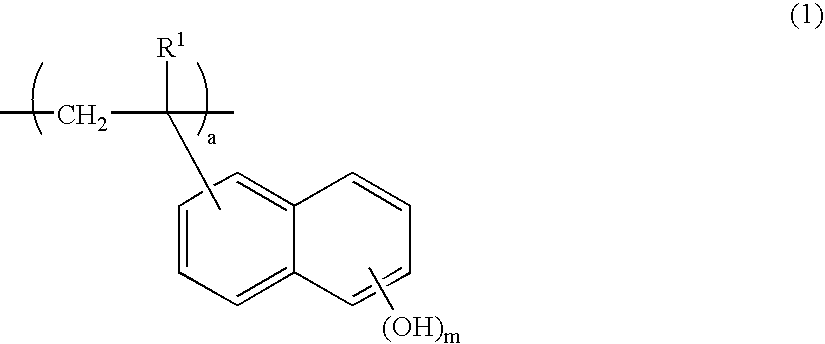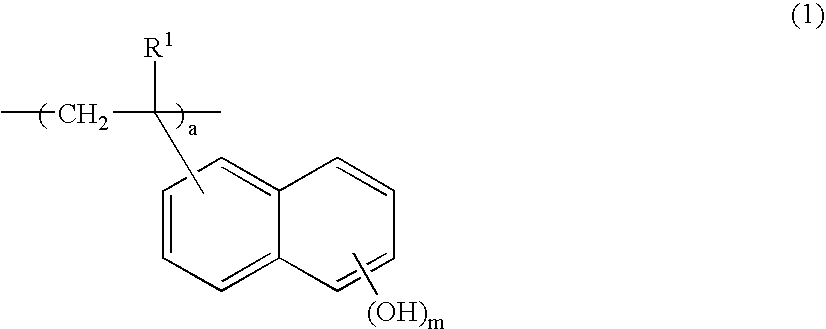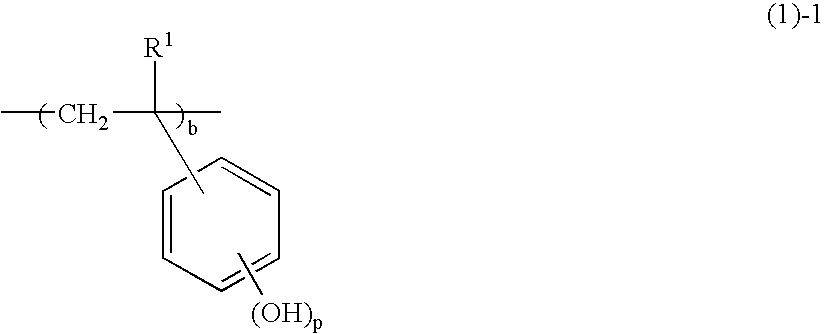Negative resist composition and patterning process using the same
a technology of composition and resist, applied in the direction of photosensitive materials, instruments, photomechanical equipment, etc., can solve the problems of line width, line width reduction, and the effect of mask fabrication techniques
- Summary
- Abstract
- Description
- Claims
- Application Information
AI Technical Summary
Benefits of technology
Problems solved by technology
Method used
Image
Examples
synthetic example 1
[0202]To a 2 L flask were added 212 g of 6-acetoxy-2-vinylnaphthalene and 250 g of toluene as a solvent. This reaction vessel was cooled to −70° C. under nitrogen atmosphere, and then degasing under reduced pressure and nitrogen blowing were repeated 3 times. After the temperature was elevated to room temperature, 8.2 g of AIBN (azobisisobutyronitrile) was added as a polymerization initiator, then the temperature was elevated to 60° C. and a reaction was conducted for 15 hours. This reaction solution was precipitated in a 5 L solution of isopropyl alcohol. Thus obtained white solid was dissolved in 500 mL of methanol and 800 mL of tetrahydrofuran. Then 50 g of triethylamine and 50 g of water were added thereto and a deprotection reaction of acetyl groups was conducted at 70° C. for 5 hours. The reaction was quenched with acetic acid. The reaction solution was concentrated, and then dissolved in 500 mL of acetone. The precipitation as with above, filtration, and drying at 60° C. were...
synthetic example 2
[0209]To a 2 L flask were added 106 g of 6-acetoxy-2-vinylnaphthalene, 81 g of 4-acetoxy styrene, and 250 g of toluene as a solvent. This reaction vessel was cooled to −70° C. under nitrogen atmosphere, and then degasing under reduced pressure and nitrogen blowing were repeated 3 times. After the temperature was elevated to room temperature, 8.2 g of AIBN (azobisisobutyronitrile) was added as a polymerization initiator, then the temperature was elevated to 60° C. and a reaction was conducted for 15 hours. This reaction solution was precipitated in a 5 L solution of isopropyl alcohol. Thus obtained white solid was dissolved in 500 mL of methanol and 800 mL of tetrahydrofuran. Then 50 g of triethylamine and 50 g of water were added thereto and a deprotection reaction of acetyl groups was conducted at 70° C. for 5 hours. The reaction was quenched with acetic acid. The reaction solution was concentrated, and then dissolved in 500 mL of acetone. The precipitation as with above, filtratio...
synthetic example 3
[0216]To a 2 L flask were added 84.8 g of 6-acetoxy-2-vinylnaphthalene, 81 g of 4-acetoxy styrene, 14.0 g of indene and 250 g of toluene as a solvent. This reaction vessel was cooled to −70° C. under nitrogen atmosphere, and then degasing under reduced pressure and nitrogen blowing were repeated 3 times. After the temperature was elevated to room temperature, 8.2 g of AIBN (azobisisobutyronitrile) was added as a polymerization initiator, then the temperature was elevated to 60° C. and a reaction was conducted for 15 hours. This reaction solution was precipitated in a 5 L solution of isopropyl alcohol. Thus obtained white solid was dissolved in 500 mL of methanol and 800 mL of tetrahydrofuran. Then 50 g of triethylamine and 50 g of water were added thereto and a deprotection reaction of acetyl groups was conducted at 70° C. for 5 hours. The reaction was quenched with acetic acid. The reaction solution was concentrated, and then dissolved in 500 mL of acetone. The precipitation as wit...
PUM
| Property | Measurement | Unit |
|---|---|---|
| width | aaaaa | aaaaa |
| time | aaaaa | aaaaa |
| time | aaaaa | aaaaa |
Abstract
Description
Claims
Application Information
 Login to View More
Login to View More - Generate Ideas
- Intellectual Property
- Life Sciences
- Materials
- Tech Scout
- Unparalleled Data Quality
- Higher Quality Content
- 60% Fewer Hallucinations
Browse by: Latest US Patents, China's latest patents, Technical Efficacy Thesaurus, Application Domain, Technology Topic, Popular Technical Reports.
© 2025 PatSnap. All rights reserved.Legal|Privacy policy|Modern Slavery Act Transparency Statement|Sitemap|About US| Contact US: help@patsnap.com



